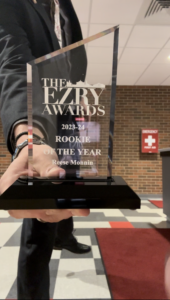By: Mary-Elizabeth Pratt
Every summer, nearby Yellow Springs turns into a haven for organic farmers and organic foodies alike. The Little Art Theater in Yellow Springs turned the winter into a way of learning more about the organic farming community by hosting a showing of “Turn Here, Sweet Corn,” a Helen de Michel documentary from 1991.
Filmed between 1988 and 1989, “Turn Here, Sweet Corn” follows Martin and Atina Diffley, fifth generation organic farmers living and farming in Eagan, Minnesota on land the family had owned for almost 140 years. The movie starts with Martin and the couple’s daughter, Liza, picking sweet corn for the family to eat for lunch as well as sell at their small vegetable stand. We are then introduced to their struggle. “Every year is our last,” Martin comments. “The land is worth a lot of money.”
Eagan had once been a small, close-knit farming community. The introduction of a freeway had brought development, and with it, the sale of most of the farms in the area. Through a process called assessment, where the farms are charged upwards of half a million dollars for the introduction of community sewer and water service near their land, many families are forced to sell their land to developers. Martin visits various other farmers in the area to discuss the developers, but everyone comes to the same conclusion: economic pressures are too great.
Eventually, the Diffley family farm succumbs to the pressure. The final scenes of the hour long documentary include Martin’s cousins, the landowners, hoping that one day the land can be returned to farm land. Martin, who stands by his belief in not using chemicals, informs the family that once the top soil is removed for the building to begin, the land will become wasteland. The family seems at odds but hopeless from both sides. We are left with Atina and Martin wishing that they can one day own their own land instead of renting.
The documentary itself is an incredibly powerful look at the role that development is playing in the failure of small, organic farms. Though filmed 25 years ago, it is no less impactful today, especially as we look at the community around Springfield, filled with cornfields and cows as far as the eye can see. The film was originally aired on PBS in July 1991; I highly recommend looking into this short and entertaining documentary. While the haircuts and turtleneck may date the film, the content seems hauntingly similar to the problems we face as a society today with GMOs, chemical spills, and the failures of small, family farms across the United States.





